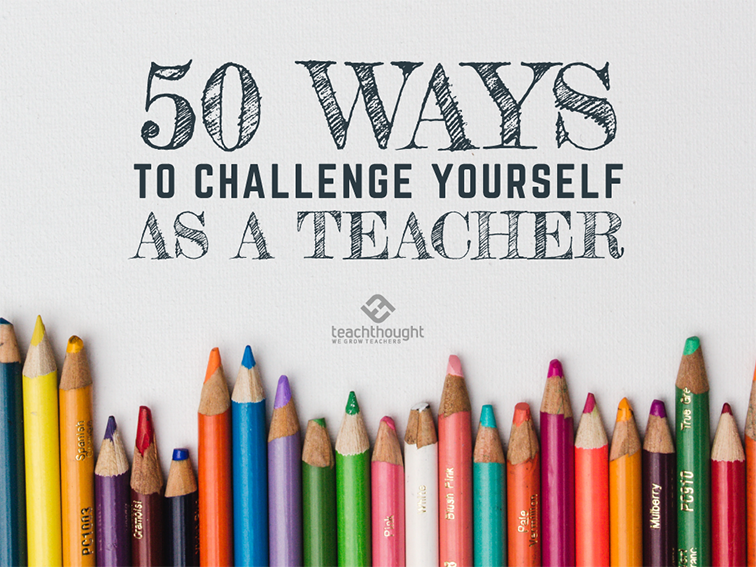
50 Ways To Challenge Yourself As Teacher
by Terry Heick
Growing as a teacher is all about challenging yourself–moving out of our comfort zone, trying something new.
If for some reason you don’t already find teaching challenging enough, here are 50 (more) ways to challenge yourself as a teacher.
- Learn a second language fluently (preferably one that is increasingly spoken in your geographical area).
- Create a closed social media community for your classroom–then use it.
- Adjust every assessment you give every time you give it until it’s the perfect assessment.
- Make sure every unit has a meaningful product of some kind that leaves the classroom.
- Think about the ‘Why’ of teaching as much as the ‘how’ of teaching (i.e., purpose and effect vs practice and application).
- Describe the approach to learning taken in your classroom in one sentence, then ask for feedback via your professional learning network on social media.
- Make sure parents understand that sentence, too.
- Experiment with using different learning models to teaching different concepts and skills and survey the pros and cons of each.
- Give equal credit for questions and answers. (Literally give ‘points’ or whatever it is you use.)
- Learn the difference between differentiation and personalization.
- Get rid of your teacher’s desk completely.
- Certify yourself in a second content area or grade level.
- Present at a local conference with a colleague or at a state or national conference (together or alone).
- Create a syllabus that’s actually useful to parents and students.
- Ensure that every single assignment is accessible to every single student in terms of reading level, background knowledge, and technology access.
- Write a research paper of at least 1000 words on the history of public education. (You may be surprised what you learn.)
- Read a book on education that seems to reflect the opposite of what you believe.
- Reach out to every single parent/family of students and create an authentic reason for them to visit your classroom this year.
- Connect every student with a mentor in the community.
- Flip your classroom.
- Laugh with your students, even if you have to play stand-up comedy.
- Shred all scripted curriculum.
- Have students record and curate the audio from every single group assignment.
- Smile at every student, every day. Or greet them at the door with a cool handshake.
- Throw out letter grades–or try additive grading.
- Assign optional homework every night; encourage those that need the practice to do it and those that don’t to create their own.
- Stay at home when you’re sick.
- Use sentence stems that reflect critical thinking so your students will, too.
- Make sure students talk more to one another than they do to you during discussions.
- Throw out all of your lessons and units and start over from scratch.
- Read to your students (e.g., from a picture book or poem) at least 10 minutes per week no matter your grade level or content area.
- Use choice boards for every assignment. (All of them.)
- Co-create all rubrics with students.
- Make it cool to read in your classroom (digital or otherwise).
- Admit when you’re wrong–mostly to your students.
- End every class with “So? So what? What now?” This is a way students can summarize what they’ve learned or you can summarize the significance of what you’ve taught.
- For every idea you disagree with while discussing ‘education,’ present a rational counterargument or solution.
- Every time you correct a student, do so with a positive presupposition that’s authentic.
- Be honest at staff meetings.
- Run a book drive in the school’s community.
- Find the line between holding yourself accountable without beating yourself up.
- Memorize your academic ‘power standards’ verbatim. Then create competencies for each power standard, and know those verbatim too.
- Create a lesson where you don’t say a single word.
- Refuse to serve on school committees that are functionally worthless.
- Videotape yourself teaching and share it with the world.
- Learn the exact differences between the academic standards from the year prior to the one you teach, and the one after.
- Decide what’s ‘most important’ in your classroom, then make sure your curriculum, units, lessons, assessments, and grading policies reflect those things.
- Make sure students and parents understand that grading policy (see above).
- Bring every student to ‘proficiency’ of every academic standard regardless of their literacy level, interest in school, attendance, background knowledge, or intellectual curiosity–then help them understand that mindset, curiosity, affections, and work ethic matter more than anything else.
50 Ways To Challenge Yourself As Teacher

